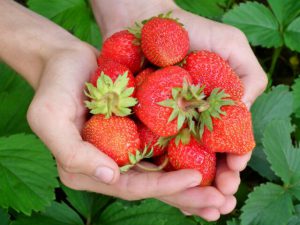There’s nothing like growing your own strawberries and picking fresh, sweet fruit right from your backyard or patio garden. Adding strawberry plants to your fall garden is easy if you follow some basic steps, and plants can now be purchased from the Baker County Master Gardeners as part of their annual fall fundraiser.
Florida Planting Dates: October and early November
In Florida, strawberry plants should be treated as annuals and replaced each year. Plants treated as perennials tend to experience problems and have reduced yields.
Varieties: Popular varieties grown in Florida include ‘Camarosa’, ‘Sweet Charlie’, ‘Camino Real’, and ‘Festival’. ‘Radiance’ is also sometimes grown in Central Florida.
Plant Spacing: 10 to 18 inches (in the ground); 6 to 8 inches (container grown)
While strawberries are traditionally planted in rows on raised beds, there are many other space-saving ways to grow them which include hanging baskets, containers, grow boxes, buckets and strawberry barrels. Growing strawberries in these alternative systems also makes it convenient when cold weather arrives since these can easily be moved to a warmer location to protect developing flowers and fruit.
Planting & Establishment: Two types of transplants are available to growers, bare-root plants and containerized transplants. Bare-root plants are the most widely available type of transplant and are typically more affordable. Bare-root plants may have leaves but are often sold as crowns without leaves. Bare-root plants, especially those with leaves, will require overhead sprinkler irrigation during the hottest part of the day for the first 7 to 12 days after planting. This reduces wilting and stress, and aids in root establishment until the plant is sufficient to support itself. Containerized transplants require much less water for re-establishment. Regardless of the type of transplant used, it is important to cover all roots, while setting the crowns of transplants at soil level. Buried crowns will result in weak plant establishment, whereas over exposed crowns will dehydrate quickly and could reduce plant population.

Fertilizing: Strawberries benefit from slow-release nitrogen which releases a steady supply of nutrients to the plants. Look for commercially available products that contain at least 30-50% slow release nitrogen. A 10-5-10 (N-P-K) formulation or similar garden fertilizer with micronutrients is recommended for in-ground plants at a rate of 2 pounds per 10 feet of row (see Growing Strawberries in the Florida Home Garden for proper plant and fertilizer placement within rows). For container grown strawberries, a 10-10-10 or similar product with micronutrients can be applied based on the product label directions.
Growth & Development: The shorter days and cooler nights of winter initiate flower formation and the fruit is ready for harvest about a month after flowers are formed. The plants will withstand freezing temperatures, but protecting early blossoms will provide earlier fruit. If a frost or freeze is predicted, covering the plants with a lightweight blanket will help prevent the flowers or fruits from getting damaged. Container grown plants can be moved to a warmer location for the night.
Harvest: The first fruits should be ready to pick in January, or roughly 90-110 days after planting. The harvest season usually stretches through May with fruit yield  peaking around March. If you have trouble with birds or rabbits stealing fruit, try using netting to protect the plants. Pick berries when at least ¾ of their surface has turned red. Once picked, the berries will not sweeten any further. Freshly picked strawberries generally keep for only a few days, so be sure to eat them soon after harvest. If you have a surplus of berries, you may freeze or preserve them.
peaking around March. If you have trouble with birds or rabbits stealing fruit, try using netting to protect the plants. Pick berries when at least ¾ of their surface has turned red. Once picked, the berries will not sweeten any further. Freshly picked strawberries generally keep for only a few days, so be sure to eat them soon after harvest. If you have a surplus of berries, you may freeze or preserve them.
Purchasing Strawberry Plants: Containerized plants are typically available from garden centers. Bare-root transplants are harder to locate, but the Baker County Master Gardeners are offering bare-root ‘Camino Real’ plants at reasonable prices as part of their annual fall fundraiser which raises money for educational programs and projects. For more information or to place an order see page 3 of The Baker Bulletin Newsletter or call (904) 259-3520.
Resources:
Growing Strawberries in the Florida Home Garden
 0
0
